HR Collaboration: Strategies, Interactions, and Knowledge Management
VerifiedAdded on 2021/02/20
|7
|1741
|130
Report
AI Summary
This report delves into the critical role of Human Resources (HR) in fostering effective collaboration with other departments within an organization. It defines collaboration, emphasizing the need for teamwork to achieve common objectives, especially in multidisciplinary environments. The report explores the nature of interactions between HR and other departments such as finance and marketing, highlighting how these collaborations support communication, transparency, and strategic alignment. It outlines the features of effective collaboration, such as clear communication, mutual trust, and active participation, while also discussing the implications of ineffective collaboration, including communication gaps and reduced productivity. Furthermore, the report examines knowledge management factors crucial for successful inter-departmental collaboration, like organizational culture and IT infrastructure. It presents the advantages and disadvantages of collaboration, identifies key departments for building collaborative relationships, and assesses the scope and limitations of such collaborations. The report concludes by emphasizing the importance of transparency and reliability in promoting effective teamwork and achieving organizational goals.
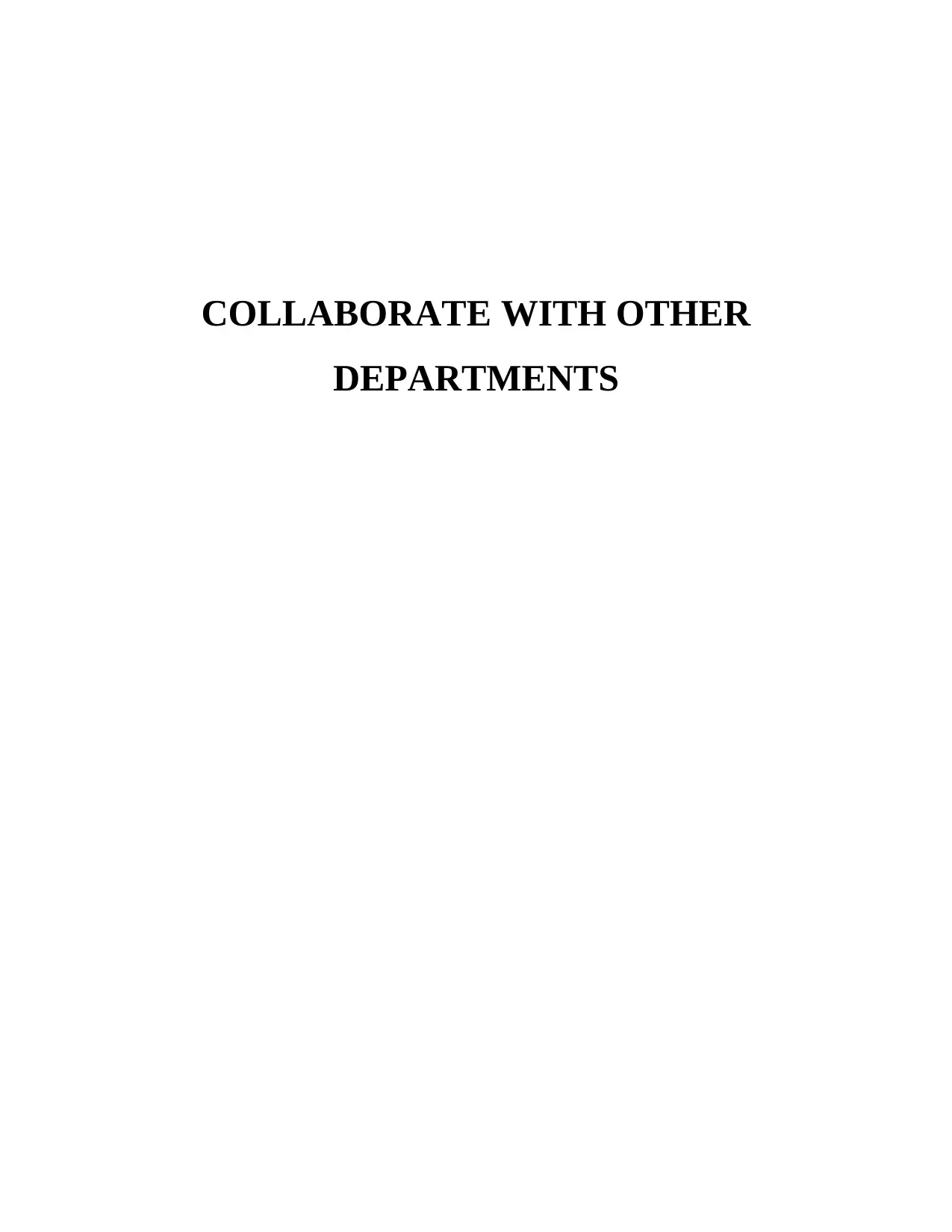
COLLABORATE WITH OTHER
DEPARTMENTS
DEPARTMENTS
Paraphrase This Document
Need a fresh take? Get an instant paraphrase of this document with our AI Paraphraser
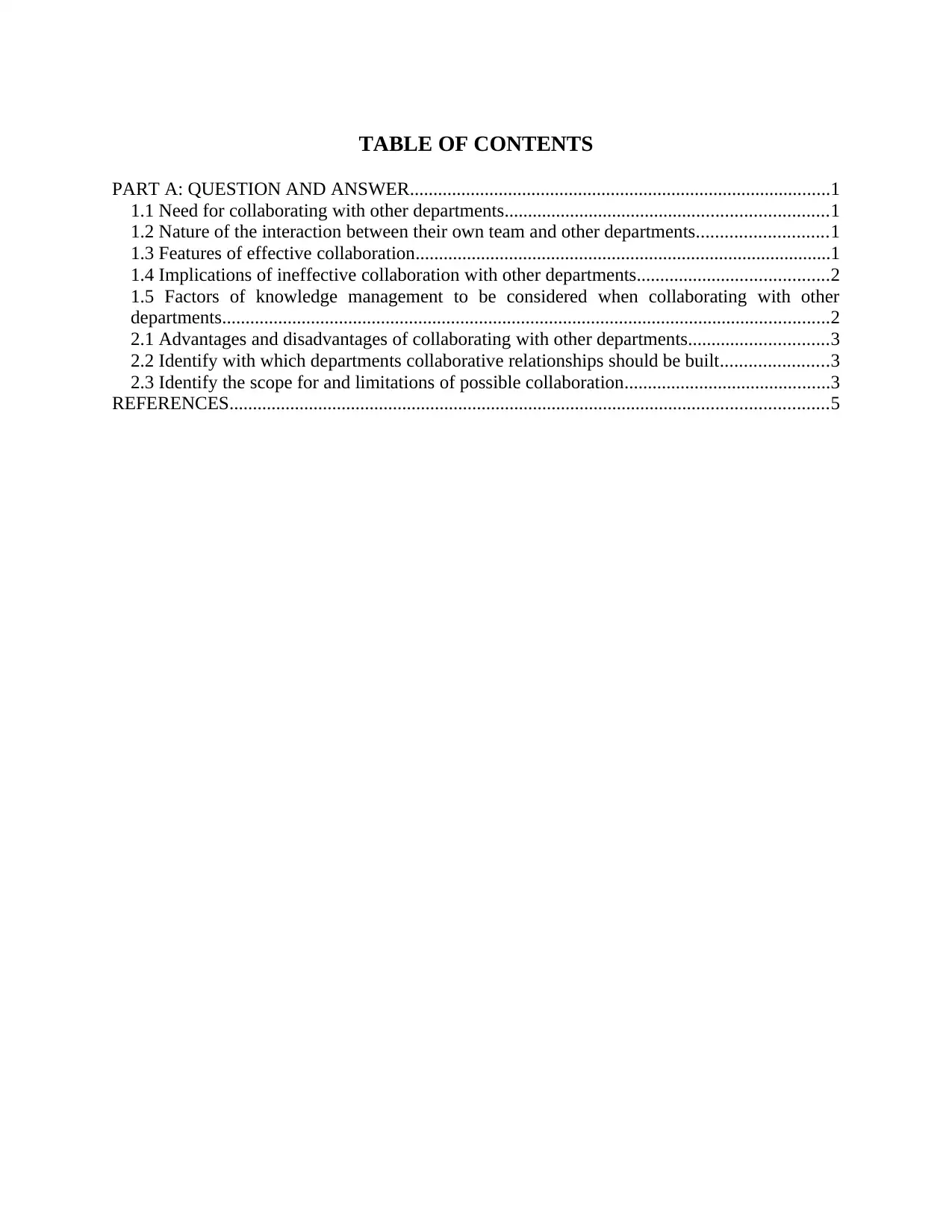
TABLE OF CONTENTS
PART A: QUESTION AND ANSWER..........................................................................................1
1.1 Need for collaborating with other departments.....................................................................1
1.2 Nature of the interaction between their own team and other departments............................1
1.3 Features of effective collaboration.........................................................................................1
1.4 Implications of ineffective collaboration with other departments.........................................2
1.5 Factors of knowledge management to be considered when collaborating with other
departments..................................................................................................................................2
2.1 Advantages and disadvantages of collaborating with other departments..............................3
2.2 Identify with which departments collaborative relationships should be built.......................3
2.3 Identify the scope for and limitations of possible collaboration............................................3
REFERENCES................................................................................................................................5
PART A: QUESTION AND ANSWER..........................................................................................1
1.1 Need for collaborating with other departments.....................................................................1
1.2 Nature of the interaction between their own team and other departments............................1
1.3 Features of effective collaboration.........................................................................................1
1.4 Implications of ineffective collaboration with other departments.........................................2
1.5 Factors of knowledge management to be considered when collaborating with other
departments..................................................................................................................................2
2.1 Advantages and disadvantages of collaborating with other departments..............................3
2.2 Identify with which departments collaborative relationships should be built.......................3
2.3 Identify the scope for and limitations of possible collaboration............................................3
REFERENCES................................................................................................................................5
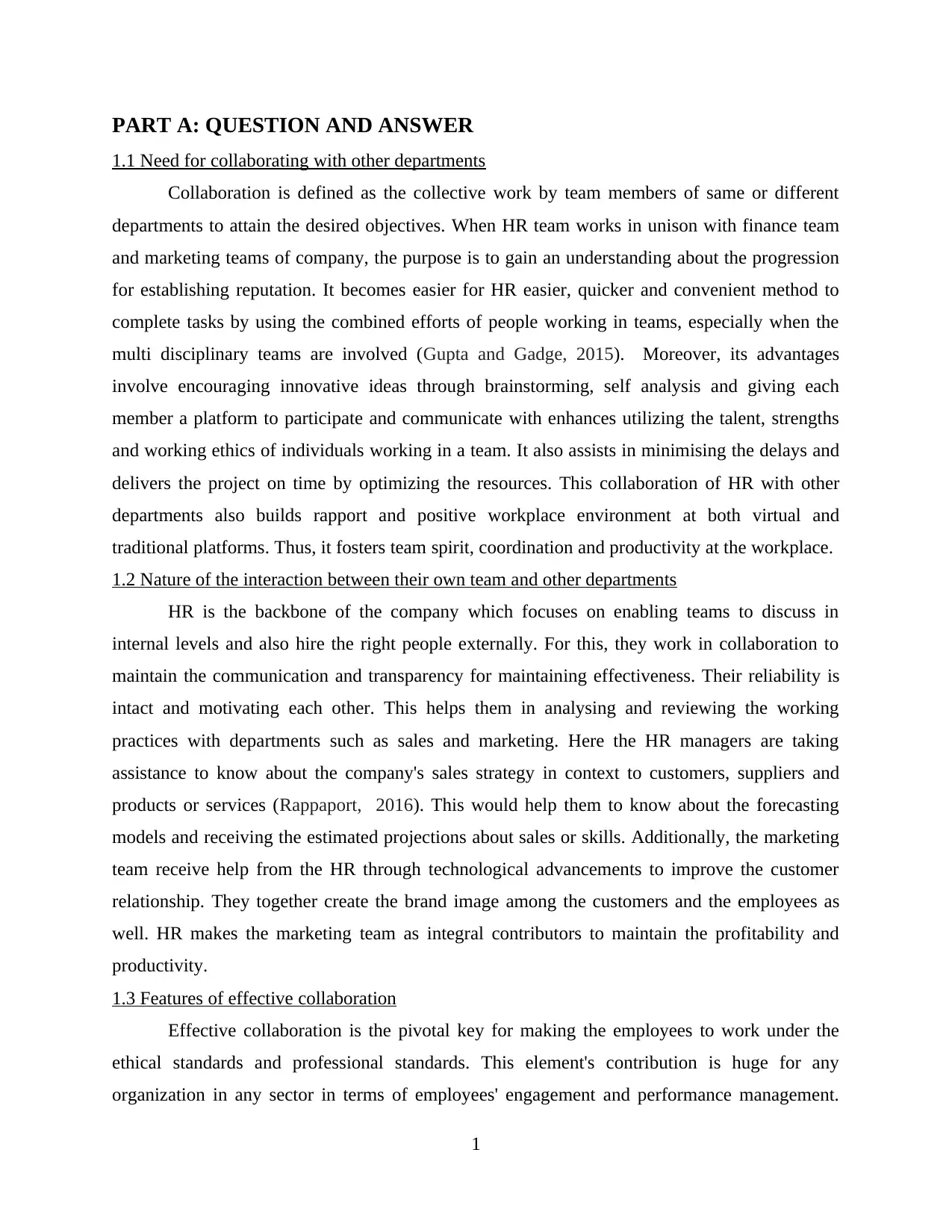
PART A: QUESTION AND ANSWER
1.1 Need for collaborating with other departments
Collaboration is defined as the collective work by team members of same or different
departments to attain the desired objectives. When HR team works in unison with finance team
and marketing teams of company, the purpose is to gain an understanding about the progression
for establishing reputation. It becomes easier for HR easier, quicker and convenient method to
complete tasks by using the combined efforts of people working in teams, especially when the
multi disciplinary teams are involved (Gupta and Gadge, 2015). Moreover, its advantages
involve encouraging innovative ideas through brainstorming, self analysis and giving each
member a platform to participate and communicate with enhances utilizing the talent, strengths
and working ethics of individuals working in a team. It also assists in minimising the delays and
delivers the project on time by optimizing the resources. This collaboration of HR with other
departments also builds rapport and positive workplace environment at both virtual and
traditional platforms. Thus, it fosters team spirit, coordination and productivity at the workplace.
1.2 Nature of the interaction between their own team and other departments
HR is the backbone of the company which focuses on enabling teams to discuss in
internal levels and also hire the right people externally. For this, they work in collaboration to
maintain the communication and transparency for maintaining effectiveness. Their reliability is
intact and motivating each other. This helps them in analysing and reviewing the working
practices with departments such as sales and marketing. Here the HR managers are taking
assistance to know about the company's sales strategy in context to customers, suppliers and
products or services (Rappaport, 2016). This would help them to know about the forecasting
models and receiving the estimated projections about sales or skills. Additionally, the marketing
team receive help from the HR through technological advancements to improve the customer
relationship. They together create the brand image among the customers and the employees as
well. HR makes the marketing team as integral contributors to maintain the profitability and
productivity.
1.3 Features of effective collaboration
Effective collaboration is the pivotal key for making the employees to work under the
ethical standards and professional standards. This element's contribution is huge for any
organization in any sector in terms of employees' engagement and performance management.
1
1.1 Need for collaborating with other departments
Collaboration is defined as the collective work by team members of same or different
departments to attain the desired objectives. When HR team works in unison with finance team
and marketing teams of company, the purpose is to gain an understanding about the progression
for establishing reputation. It becomes easier for HR easier, quicker and convenient method to
complete tasks by using the combined efforts of people working in teams, especially when the
multi disciplinary teams are involved (Gupta and Gadge, 2015). Moreover, its advantages
involve encouraging innovative ideas through brainstorming, self analysis and giving each
member a platform to participate and communicate with enhances utilizing the talent, strengths
and working ethics of individuals working in a team. It also assists in minimising the delays and
delivers the project on time by optimizing the resources. This collaboration of HR with other
departments also builds rapport and positive workplace environment at both virtual and
traditional platforms. Thus, it fosters team spirit, coordination and productivity at the workplace.
1.2 Nature of the interaction between their own team and other departments
HR is the backbone of the company which focuses on enabling teams to discuss in
internal levels and also hire the right people externally. For this, they work in collaboration to
maintain the communication and transparency for maintaining effectiveness. Their reliability is
intact and motivating each other. This helps them in analysing and reviewing the working
practices with departments such as sales and marketing. Here the HR managers are taking
assistance to know about the company's sales strategy in context to customers, suppliers and
products or services (Rappaport, 2016). This would help them to know about the forecasting
models and receiving the estimated projections about sales or skills. Additionally, the marketing
team receive help from the HR through technological advancements to improve the customer
relationship. They together create the brand image among the customers and the employees as
well. HR makes the marketing team as integral contributors to maintain the profitability and
productivity.
1.3 Features of effective collaboration
Effective collaboration is the pivotal key for making the employees to work under the
ethical standards and professional standards. This element's contribution is huge for any
organization in any sector in terms of employees' engagement and performance management.
1
⊘ This is a preview!⊘
Do you want full access?
Subscribe today to unlock all pages.

Trusted by 1+ million students worldwide
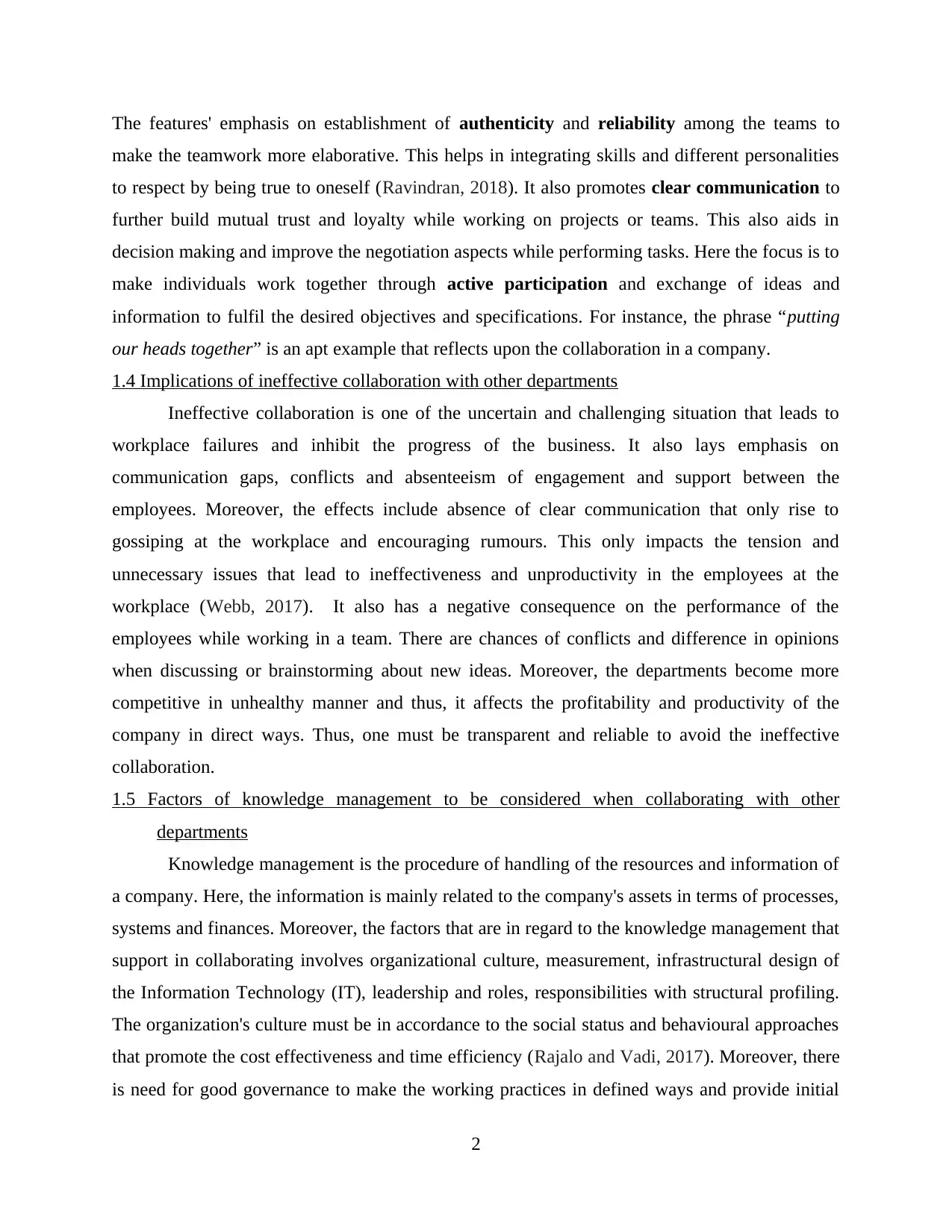
The features' emphasis on establishment of authenticity and reliability among the teams to
make the teamwork more elaborative. This helps in integrating skills and different personalities
to respect by being true to oneself (Ravindran, 2018). It also promotes clear communication to
further build mutual trust and loyalty while working on projects or teams. This also aids in
decision making and improve the negotiation aspects while performing tasks. Here the focus is to
make individuals work together through active participation and exchange of ideas and
information to fulfil the desired objectives and specifications. For instance, the phrase “putting
our heads together” is an apt example that reflects upon the collaboration in a company.
1.4 Implications of ineffective collaboration with other departments
Ineffective collaboration is one of the uncertain and challenging situation that leads to
workplace failures and inhibit the progress of the business. It also lays emphasis on
communication gaps, conflicts and absenteeism of engagement and support between the
employees. Moreover, the effects include absence of clear communication that only rise to
gossiping at the workplace and encouraging rumours. This only impacts the tension and
unnecessary issues that lead to ineffectiveness and unproductivity in the employees at the
workplace (Webb, 2017). It also has a negative consequence on the performance of the
employees while working in a team. There are chances of conflicts and difference in opinions
when discussing or brainstorming about new ideas. Moreover, the departments become more
competitive in unhealthy manner and thus, it affects the profitability and productivity of the
company in direct ways. Thus, one must be transparent and reliable to avoid the ineffective
collaboration.
1.5 Factors of knowledge management to be considered when collaborating with other
departments
Knowledge management is the procedure of handling of the resources and information of
a company. Here, the information is mainly related to the company's assets in terms of processes,
systems and finances. Moreover, the factors that are in regard to the knowledge management that
support in collaborating involves organizational culture, measurement, infrastructural design of
the Information Technology (IT), leadership and roles, responsibilities with structural profiling.
The organization's culture must be in accordance to the social status and behavioural approaches
that promote the cost effectiveness and time efficiency (Rajalo and Vadi, 2017). Moreover, there
is need for good governance to make the working practices in defined ways and provide initial
2
make the teamwork more elaborative. This helps in integrating skills and different personalities
to respect by being true to oneself (Ravindran, 2018). It also promotes clear communication to
further build mutual trust and loyalty while working on projects or teams. This also aids in
decision making and improve the negotiation aspects while performing tasks. Here the focus is to
make individuals work together through active participation and exchange of ideas and
information to fulfil the desired objectives and specifications. For instance, the phrase “putting
our heads together” is an apt example that reflects upon the collaboration in a company.
1.4 Implications of ineffective collaboration with other departments
Ineffective collaboration is one of the uncertain and challenging situation that leads to
workplace failures and inhibit the progress of the business. It also lays emphasis on
communication gaps, conflicts and absenteeism of engagement and support between the
employees. Moreover, the effects include absence of clear communication that only rise to
gossiping at the workplace and encouraging rumours. This only impacts the tension and
unnecessary issues that lead to ineffectiveness and unproductivity in the employees at the
workplace (Webb, 2017). It also has a negative consequence on the performance of the
employees while working in a team. There are chances of conflicts and difference in opinions
when discussing or brainstorming about new ideas. Moreover, the departments become more
competitive in unhealthy manner and thus, it affects the profitability and productivity of the
company in direct ways. Thus, one must be transparent and reliable to avoid the ineffective
collaboration.
1.5 Factors of knowledge management to be considered when collaborating with other
departments
Knowledge management is the procedure of handling of the resources and information of
a company. Here, the information is mainly related to the company's assets in terms of processes,
systems and finances. Moreover, the factors that are in regard to the knowledge management that
support in collaborating involves organizational culture, measurement, infrastructural design of
the Information Technology (IT), leadership and roles, responsibilities with structural profiling.
The organization's culture must be in accordance to the social status and behavioural approaches
that promote the cost effectiveness and time efficiency (Rajalo and Vadi, 2017). Moreover, there
is need for good governance to make the working practices in defined ways and provide initial
2
Paraphrase This Document
Need a fresh take? Get an instant paraphrase of this document with our AI Paraphraser
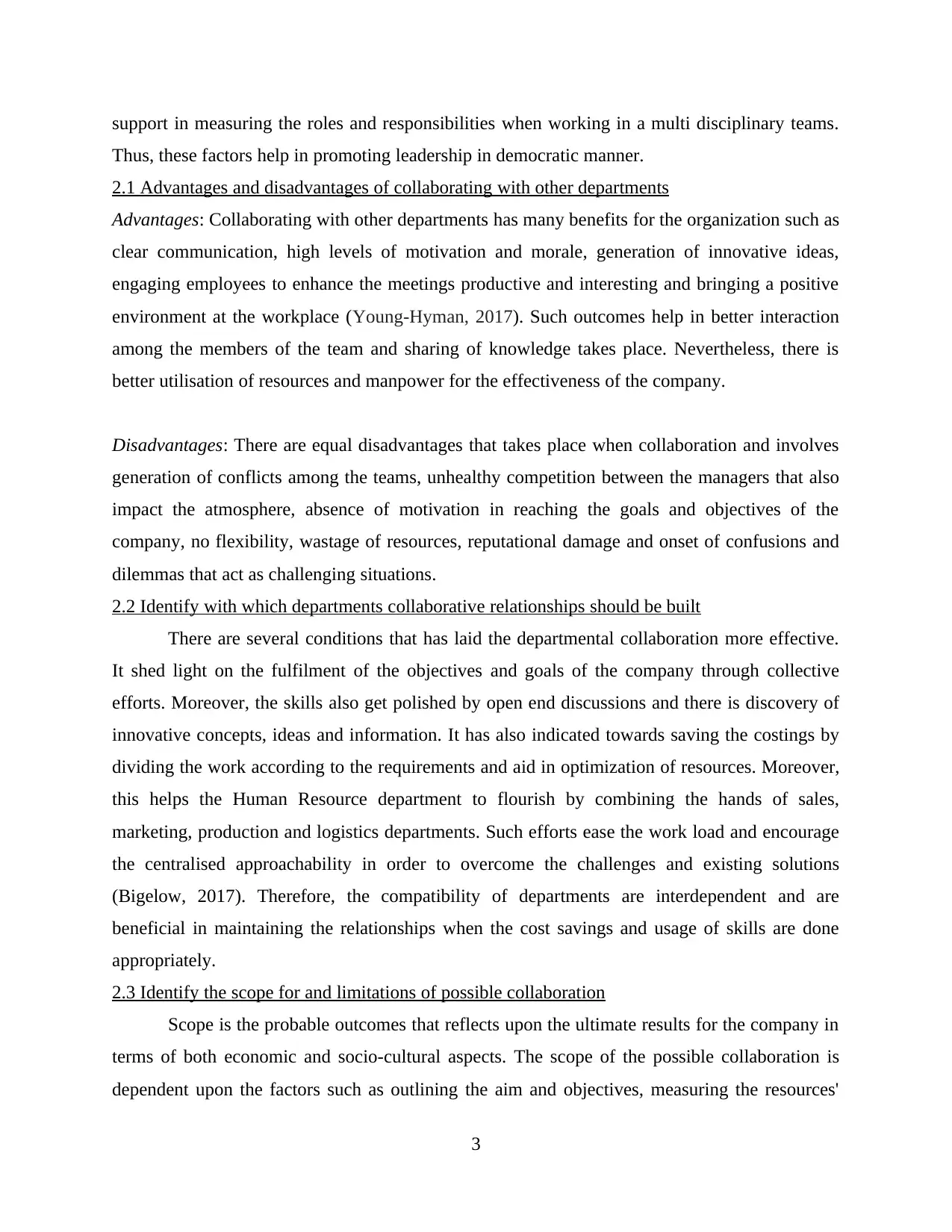
support in measuring the roles and responsibilities when working in a multi disciplinary teams.
Thus, these factors help in promoting leadership in democratic manner.
2.1 Advantages and disadvantages of collaborating with other departments
Advantages: Collaborating with other departments has many benefits for the organization such as
clear communication, high levels of motivation and morale, generation of innovative ideas,
engaging employees to enhance the meetings productive and interesting and bringing a positive
environment at the workplace (Young-Hyman, 2017). Such outcomes help in better interaction
among the members of the team and sharing of knowledge takes place. Nevertheless, there is
better utilisation of resources and manpower for the effectiveness of the company.
Disadvantages: There are equal disadvantages that takes place when collaboration and involves
generation of conflicts among the teams, unhealthy competition between the managers that also
impact the atmosphere, absence of motivation in reaching the goals and objectives of the
company, no flexibility, wastage of resources, reputational damage and onset of confusions and
dilemmas that act as challenging situations.
2.2 Identify with which departments collaborative relationships should be built
There are several conditions that has laid the departmental collaboration more effective.
It shed light on the fulfilment of the objectives and goals of the company through collective
efforts. Moreover, the skills also get polished by open end discussions and there is discovery of
innovative concepts, ideas and information. It has also indicated towards saving the costings by
dividing the work according to the requirements and aid in optimization of resources. Moreover,
this helps the Human Resource department to flourish by combining the hands of sales,
marketing, production and logistics departments. Such efforts ease the work load and encourage
the centralised approachability in order to overcome the challenges and existing solutions
(Bigelow, 2017). Therefore, the compatibility of departments are interdependent and are
beneficial in maintaining the relationships when the cost savings and usage of skills are done
appropriately.
2.3 Identify the scope for and limitations of possible collaboration
Scope is the probable outcomes that reflects upon the ultimate results for the company in
terms of both economic and socio-cultural aspects. The scope of the possible collaboration is
dependent upon the factors such as outlining the aim and objectives, measuring the resources'
3
Thus, these factors help in promoting leadership in democratic manner.
2.1 Advantages and disadvantages of collaborating with other departments
Advantages: Collaborating with other departments has many benefits for the organization such as
clear communication, high levels of motivation and morale, generation of innovative ideas,
engaging employees to enhance the meetings productive and interesting and bringing a positive
environment at the workplace (Young-Hyman, 2017). Such outcomes help in better interaction
among the members of the team and sharing of knowledge takes place. Nevertheless, there is
better utilisation of resources and manpower for the effectiveness of the company.
Disadvantages: There are equal disadvantages that takes place when collaboration and involves
generation of conflicts among the teams, unhealthy competition between the managers that also
impact the atmosphere, absence of motivation in reaching the goals and objectives of the
company, no flexibility, wastage of resources, reputational damage and onset of confusions and
dilemmas that act as challenging situations.
2.2 Identify with which departments collaborative relationships should be built
There are several conditions that has laid the departmental collaboration more effective.
It shed light on the fulfilment of the objectives and goals of the company through collective
efforts. Moreover, the skills also get polished by open end discussions and there is discovery of
innovative concepts, ideas and information. It has also indicated towards saving the costings by
dividing the work according to the requirements and aid in optimization of resources. Moreover,
this helps the Human Resource department to flourish by combining the hands of sales,
marketing, production and logistics departments. Such efforts ease the work load and encourage
the centralised approachability in order to overcome the challenges and existing solutions
(Bigelow, 2017). Therefore, the compatibility of departments are interdependent and are
beneficial in maintaining the relationships when the cost savings and usage of skills are done
appropriately.
2.3 Identify the scope for and limitations of possible collaboration
Scope is the probable outcomes that reflects upon the ultimate results for the company in
terms of both economic and socio-cultural aspects. The scope of the possible collaboration is
dependent upon the factors such as outlining the aim and objectives, measuring the resources'
3
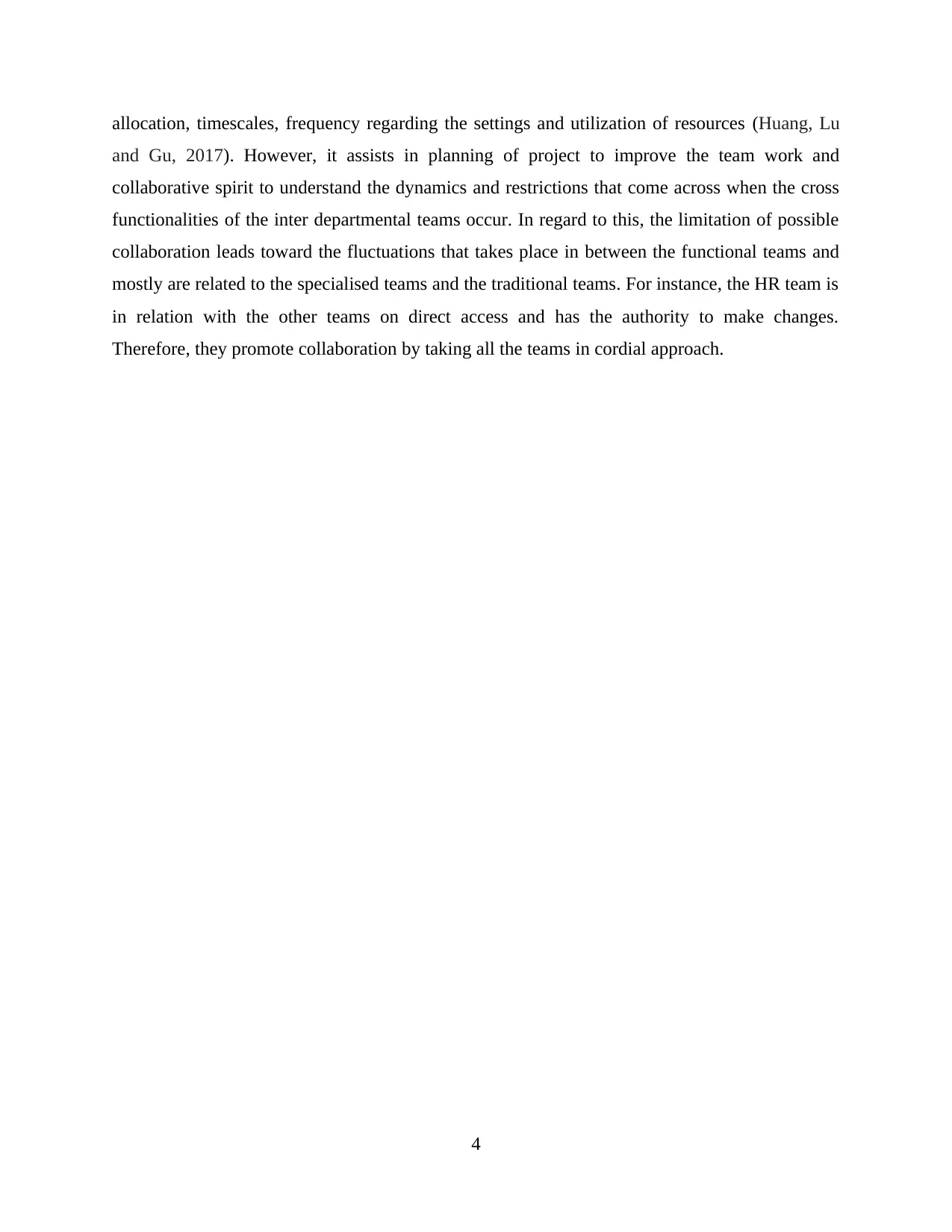
allocation, timescales, frequency regarding the settings and utilization of resources (Huang, Lu
and Gu, 2017). However, it assists in planning of project to improve the team work and
collaborative spirit to understand the dynamics and restrictions that come across when the cross
functionalities of the inter departmental teams occur. In regard to this, the limitation of possible
collaboration leads toward the fluctuations that takes place in between the functional teams and
mostly are related to the specialised teams and the traditional teams. For instance, the HR team is
in relation with the other teams on direct access and has the authority to make changes.
Therefore, they promote collaboration by taking all the teams in cordial approach.
4
and Gu, 2017). However, it assists in planning of project to improve the team work and
collaborative spirit to understand the dynamics and restrictions that come across when the cross
functionalities of the inter departmental teams occur. In regard to this, the limitation of possible
collaboration leads toward the fluctuations that takes place in between the functional teams and
mostly are related to the specialised teams and the traditional teams. For instance, the HR team is
in relation with the other teams on direct access and has the authority to make changes.
Therefore, they promote collaboration by taking all the teams in cordial approach.
4
⊘ This is a preview!⊘
Do you want full access?
Subscribe today to unlock all pages.

Trusted by 1+ million students worldwide
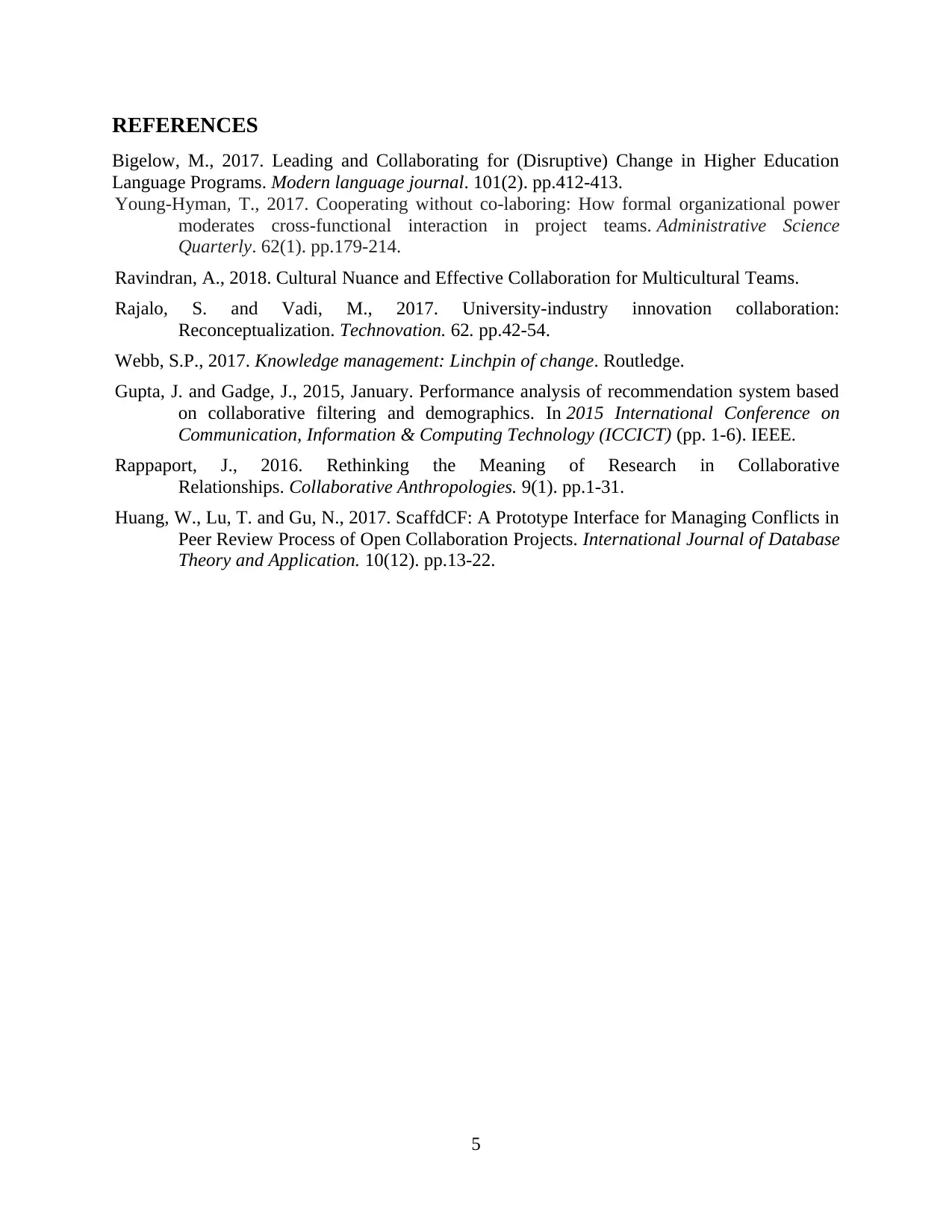
REFERENCES
Bigelow, M., 2017. Leading and Collaborating for (Disruptive) Change in Higher Education
Language Programs. Modern language journal. 101(2). pp.412-413.
Young-Hyman, T., 2017. Cooperating without co-laboring: How formal organizational power
moderates cross-functional interaction in project teams. Administrative Science
Quarterly. 62(1). pp.179-214.
Ravindran, A., 2018. Cultural Nuance and Effective Collaboration for Multicultural Teams.
Rajalo, S. and Vadi, M., 2017. University-industry innovation collaboration:
Reconceptualization. Technovation. 62. pp.42-54.
Webb, S.P., 2017. Knowledge management: Linchpin of change. Routledge.
Gupta, J. and Gadge, J., 2015, January. Performance analysis of recommendation system based
on collaborative filtering and demographics. In 2015 International Conference on
Communication, Information & Computing Technology (ICCICT) (pp. 1-6). IEEE.
Rappaport, J., 2016. Rethinking the Meaning of Research in Collaborative
Relationships. Collaborative Anthropologies. 9(1). pp.1-31.
Huang, W., Lu, T. and Gu, N., 2017. ScaffdCF: A Prototype Interface for Managing Conflicts in
Peer Review Process of Open Collaboration Projects. International Journal of Database
Theory and Application. 10(12). pp.13-22.
5
Bigelow, M., 2017. Leading and Collaborating for (Disruptive) Change in Higher Education
Language Programs. Modern language journal. 101(2). pp.412-413.
Young-Hyman, T., 2017. Cooperating without co-laboring: How formal organizational power
moderates cross-functional interaction in project teams. Administrative Science
Quarterly. 62(1). pp.179-214.
Ravindran, A., 2018. Cultural Nuance and Effective Collaboration for Multicultural Teams.
Rajalo, S. and Vadi, M., 2017. University-industry innovation collaboration:
Reconceptualization. Technovation. 62. pp.42-54.
Webb, S.P., 2017. Knowledge management: Linchpin of change. Routledge.
Gupta, J. and Gadge, J., 2015, January. Performance analysis of recommendation system based
on collaborative filtering and demographics. In 2015 International Conference on
Communication, Information & Computing Technology (ICCICT) (pp. 1-6). IEEE.
Rappaport, J., 2016. Rethinking the Meaning of Research in Collaborative
Relationships. Collaborative Anthropologies. 9(1). pp.1-31.
Huang, W., Lu, T. and Gu, N., 2017. ScaffdCF: A Prototype Interface for Managing Conflicts in
Peer Review Process of Open Collaboration Projects. International Journal of Database
Theory and Application. 10(12). pp.13-22.
5
1 out of 7
Related Documents
Your All-in-One AI-Powered Toolkit for Academic Success.
+13062052269
info@desklib.com
Available 24*7 on WhatsApp / Email
![[object Object]](/_next/static/media/star-bottom.7253800d.svg)
Unlock your academic potential
Copyright © 2020–2025 A2Z Services. All Rights Reserved. Developed and managed by ZUCOL.




